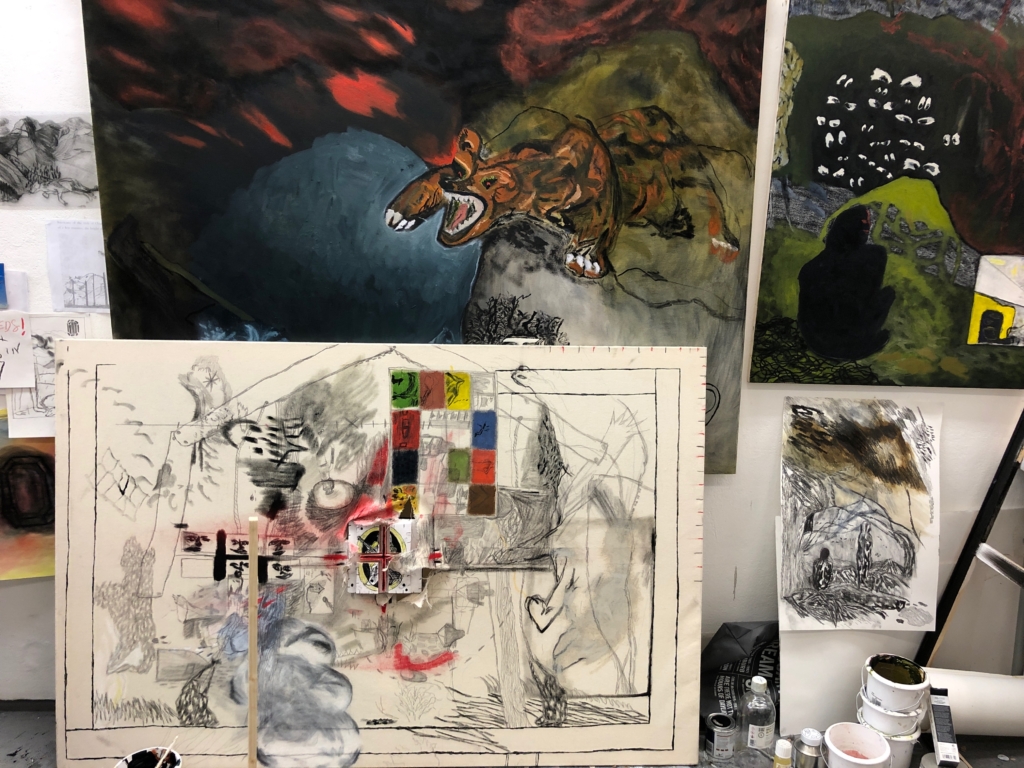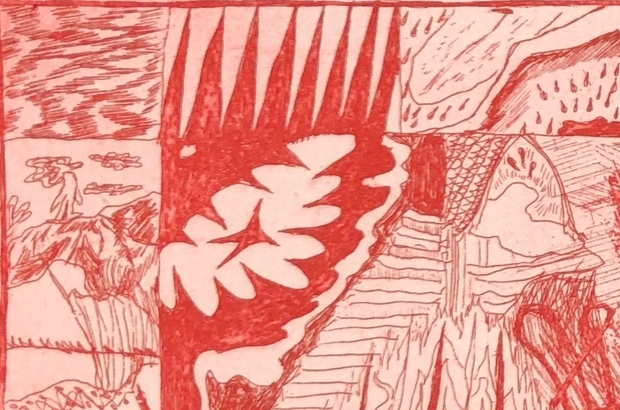EMILY WEBB is a multi-disciplinary artist in her third year at the Slade. She is a painter, printmaker, writer, and music-maker. JEAN WATT interviewed her about her practice.
What have you been up to at the moment?
I’ve been finding it quite hard to do art to be honest, and a lot of my stuff had to be left at the Slade before the lockdown. So I’ve been playing a lot of my harp because I have so much free time at the moment.
How long have you been playing the harp?
I started learning in January, so not long, but it’s a really fun instrument to make noises with, freestyle; it’s quite an intuitive instrument. And because you hug it, it’s a really physical experience. I find it super relaxing, you can just play it for hours and you forget. I’ve also done some radio shows with harp on VIPMIX and a radio station in New York called Montez Press Radio. I like to play around with the sounds I make in Ableton. I feel like the way that I do that is similar to the way that I do my art: manipulating little fragments and turning them into something completely different.
Do you see that as an extension of your art practice or is it a separate aspect to your life?
I think the drive is similar but I think it’s aesthetically different. I don’t know if I’d want them sitting side by side, or if they affect each other. Although it has been quite useful for me in recognising that this is how I enjoy working, taking these tiny fragments and exploring the different ways that they can exist.
It’s interesting to have something which definitely informs your artistic process but is not something you want to show in an art space…
Exactly. I think when you do something like painting as your main practice and then you do something else, then people seem to automatically tie them together. But actually they can stand on their own and it’s just a different form of using your method of doing to do something else. Maybe inevitably, I find that all these things end up being similar in their end result. My music and art have this fragmentary nature, and I end up with things that maybe seem not quite right, but they work.

Yeah I understand; something doesn’t have to make a whole, and that’s not what you set out to do, but in exploring these different fragments they become part of something bigger.
Totally. Also by mapping out the ways in which things have come to be, and the stories that come into the making of the thing and then disappear and become something else.
That’s interesting that you bring up stories because I think language seems important to your art practice, which we’ve talked about before – the interpretative breadth of language compared to fixed visual representation. Can you talk a bit about your writing?
I write a lot of short stories and usually they’re not standalone things but rather notes or ideas that I don’t want to put into a picture. There are so many elements of visual language that get lost in written language and vice versa and sometimes I find it easier to do a drawing and then do the story and sometimes I find it easier to draw or paint the story. So it feels like a form of note taking. I wrote this short story for a magazine about a year ago and it got chosen for the book, Best Microfiction 2020 which was really exciting and unexpected. I had never heard of microfiction before; it’s this book full of tiny stories.
What else can you tell me about your visual work?
I think with my painting and etchings, the way that they come about stems from a lot of what I’ve been saying already. They all exist in the same universe where these different things are happening and I zoom in on a little vignette of this strange lost scene. Maybe the moment would have passed if it hadn’t been painted, but it also doesn’t exist. Also, in my paintings there are a lot of motifs and symbols. I like symbols a lot, I think they are really exciting for a viewer.

And that links back to language as well and this desire to decipher something…
Exactly, and it becomes this sort of weird Wingding, but then you recognise it. Or a signifier in the painting from which everything in the painting comes from and it reigns over that one world. Then you might see it as a small part of another of my paintings, and it indicates that there are these carriers-on and they exist in different ways.
Definitely, because I think what I see in your paintings is that there are internal narratives and elements of each painting which make sense in relation to each other and then there’s also an external sphere which relates to other things you’ve made. And there are these two parallel conversations happening within and outside of the work.
Yeah, exactly, that’s great.
Do you have any artists, writers, or creators that you find particularly inspiring?
I love Goya, because he’s terrifying and everything in his artworks feels like it’s about to fall apart. At the moment, I’m reading Lanark by Alasdair Grey. It’s set in Glasgow and it’s like a hellish fantasy and a kind of dour realism combined. Grey went to the Glasgow School of Art, and a lot of his illustrations are in the book. They’re really intricate and beautiful. One of my favourite books is Walking Through Clear Water In A Pool Painted Black, a memoir by Cookie Mueller who was in a lot of John Waters films. It’s really short and funny and wild. She throws a giant flaming oven overboard a yacht.
What has this period of lockdown taught you? Do you think it will change how you approach working?
I’ve really got into paper maché! I’ve been making a theatre box. It’s small! Go small! That’s what lockdown has taught me.

You can find Emily on instagram @emilyf.webb, listen to her radio shows on VIPMIX (1&2), Montez Press and read her microfiction in Best Microfiction 2020.





